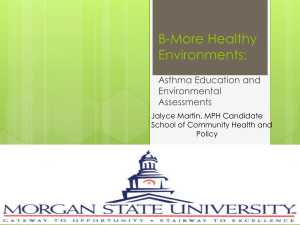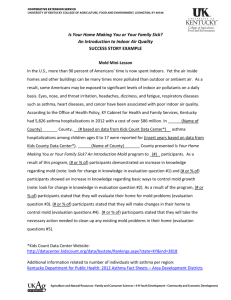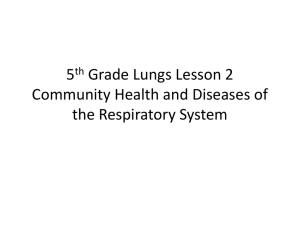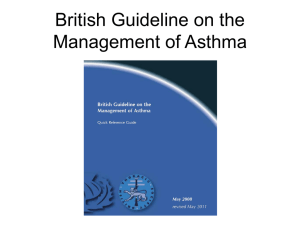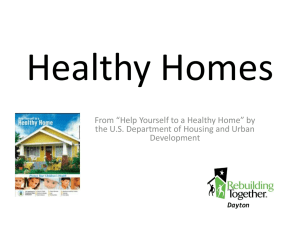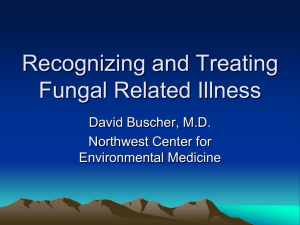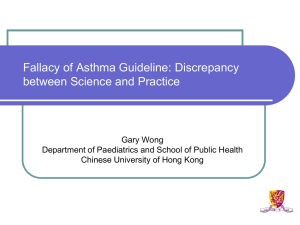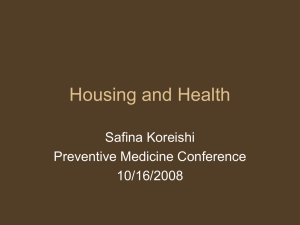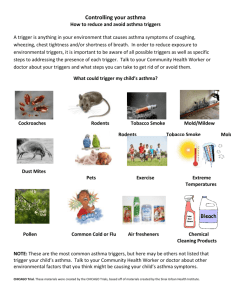PRESENTATION NAME - National Center for Healthy Housing
advertisement
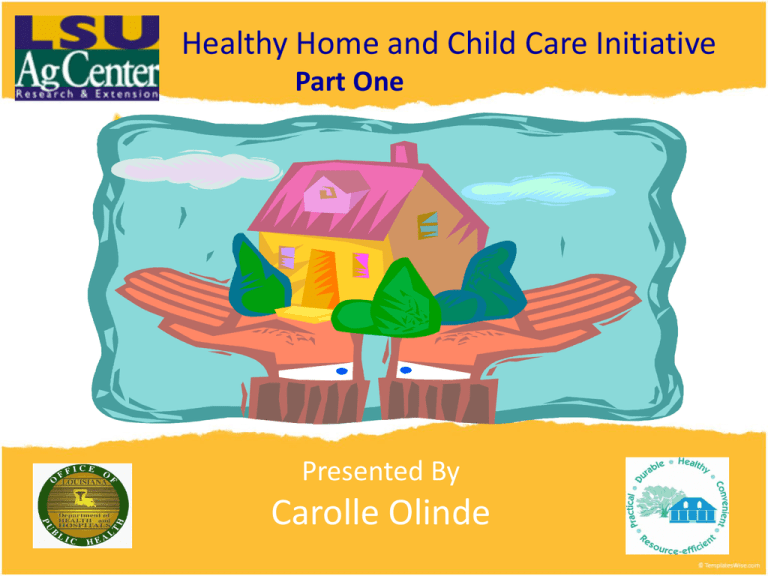
Healthy Home and Child Care Initiative Part One Presented By Carolle Olinde Acknowledgements The information has been adapted from the Healthy Homes Partnership’s Department of Housing and Urban Development (HUD) United States Department of Agriculture (USDA) through Cooperative State Research, Education, and Extension Service (CSREES) Louisiana Department of Health and Hospitals (LDHH) Part One Today’s session will cover pages 1-28 of the Help Yourself to a Healthy Home publication This publication is available online at: http://www.healthyhomespartnership.net/book.html Help Yourself to a Healthy Home Part One Pre - Knowledge Test What is a healthy home and childcare? • A healthy home or child care facility is an environment designed, constructed, maintained, or rehabilitated in a manner that supports the health of residents/occupants. • A growing body of evidence links housing conditions to health outcomes such as asthma, lead poisoning, lung cancer, and unintentional injuries. Why focus on Healthy Homes and Childcare? • Reduce health hazards • Improve substandard housing and child care facilities • Help improve public health. • Promote the growth and development of our children • Save billions of dollars in health care costs. Seven Principles of Healthy Homes and Childcare • • • • • • • Keep it dry Keep it clean Keep it pest-free Keep it ventilated Keep it safe Keep it contaminate-free Keep it maintained ASK YOURSELF Is the air in your home or child care clean and healthy? Do your children have breathing problems, like asthma? Is someone in your home or child care allergic to mold? Do you know the signs of carbon monoxide poisoning? Is there lead anywhere in your home? Is your tap water safe to drink? Do you have household products with chemicals in them that can make you sick? Do you use bug spray or other products to keep away pests? Do you keep poisons where your children can reach them? Today we will try to answer some of these questions and give you ideas about how to protect yourself and children’s health. Why is this important? Why focus on children? • Some of the most serious health problems for children start at home and in child care settings • Most people spend over 90% of their time indoors • Children’s bodies are still growing • Children crawl and play on the ground, thus increasing exposure Indoor Air Quality Concerns • The number of children with asthma has doubled in the past 10 years • 1 in 15 children under 18 year of age has asthma Lead Poisoning Concerns • 1 in 40 American children has too much lead in his or her body • Dust from lead paint is the biggest threat to young children • Lead in drinking water is also a problem Drinking Water Concerns • 95% of people living in rural areas use private wells for their drinking water Hazardous Household Products Concerns Thousands of children die each year from chemicals stored and used improperly in the home Concerns About Pesticides Nearly one-half of households with a child under the age of five had pesticides stored within reach of children. Concerns About Safety Each year over 6 million people are hurt in accidents that occur in the home Indoor Air Quality Should you be concerned? • Sometimes indoor air problems come from what people DO in their homes • Sometimes indoor air problems come from what people HAVE in their homes The Problem With VOC’s Questions to Ask – page 8 • About your family’s or children’s health • About radon • About living in your home or your child care center IAQ – Asthma Connection • Indoor Air Quality (IAQ) • Children spend approximately 90% of their time indoors • Reducing asthma triggers can reduce asthma symptoms Indoor Air Quality Action Steps • Do not smoke in the home or around children • Keep pets out of bedrooms & living areas • Pay attention to housekeeping • Use open windows and fans when using chemicals • New carpet – should air before installing; install in spring, summer or fall • New furniture & building materials – air before bringing into house; purchase products that are ‘green’ Asthma and Allergies Should you be concerned? • • • • ATTACK SIGNS Tightness in chest Shortness of breath Wheezing Coughing ASTHMA TRIGGERS • • • • • • • • • • Cold weather, exercise, strong emotions, Pollen DANDER PESTS SMOKE DUST MOLD Carbon Monoxide Personal care and cleaning products Flu & colds Asthma and Allergies SIGNS/SYMPTOMS • Runny nose • Stuffy nose • Coughing • Hives • Itching • Rash • Puffy eyes • Watery eyes COMMON ALLERGENS • Foods • Medicines • Insect stings an bites • Contact allergens • Asthma triggers Asthma & Allergies – Questions to Ask • Does anyone in your family have asthma or allergies? • Does someone in your family notice burning eyes, coughing, or sneezing that happens most often at home? • Does your home have carpet that is not cleaned well or not cleaned often? • Do you have carpeting, stuffed toys or fleecy materials in bedrooms? • Do you keep pets inside? • How often do you wash sheets, blankets and other bedding? • Do you sotre food in containers or boxes that do not have covers? • Has it been more than a year since you have your furnace, flues and chimneys inspected and cleaned? • Does anyone smoke inside your home? • Is your home damp or musty? Asthma & Allergy Action Steps • Attend to your asthma and allergies • Focus on housekeeping • Control dustmites • Control pests • Manage pets • Check appliances • NO SMOKING • Address mold Learning Activity • Show and Tell Mold and Moisture Should you be concerned? • Mold locations: – Bathrooms – Sinks – Attics under leaky roofs – Wet clothes – Windows and walls – Closets – Under wallpaper or carpet – Air conditioner Questions to Ask – page 18 • Family’s Health • Home Mold Assessment • Presence of Moisture Mold & Mildew Action Steps Small Steps to Healthier Child Care Mold & Mildew Action Steps How do I clean up mold? How do I test for mold? Carbon Monoxide Should you be concerned? Attributes of CO Sources of CO • Invisible • Fuel burning appliances – Gas & oil furnaces • Tasteless – Wood-burning fireplaces & stoves • Odorless – Gas appliances • Deadly – Gas/kerosene space heaters • 500 CO U. S. deaths – Gas/charcoal grills annually – Vehicles • Brain damage – Gas/propane powered appliances – Recreational vehicles • Loss of sight & hearing – Tobacco smoke • Heart problems – House fires, blocked chimneys/flues Carbon Monoxide Should you be concerned? Effects of CO • Low levels can hurt brain, heart, and other organs • High levels affect clear thinking, muscle control, consciousness Signs of CO Poisoning • • • • • • • • • • Headache Nausea Vomiting Dizziness Confusion Tired Weak Sleepy Tight chest/trouble breathing Changes in senses Questions to Ask – page 25 Checklist for CO Let’s check! Carbon Monoxide Action Steps • Grills & engines • Vehicle • Annual checks for heaters & fireplaces • CO alarms • Ovens & stoves • Exhaust fan • Gas range top • Do not use smoking fireplace Carbon Monoxide Action Steps • STEPS IF CO ALARM GOES OFF – – – – – – GO OUTSIDE 911 DOCTOR/NURSE DO NOT IGNORE CHECK BY CONTRACTOR DO NOT RETURN HOME UNTIL PROBLEM IS CORRECTED Healthy Home and Child Care Initiative Part One - SUMMARY By Carolle Olinde
